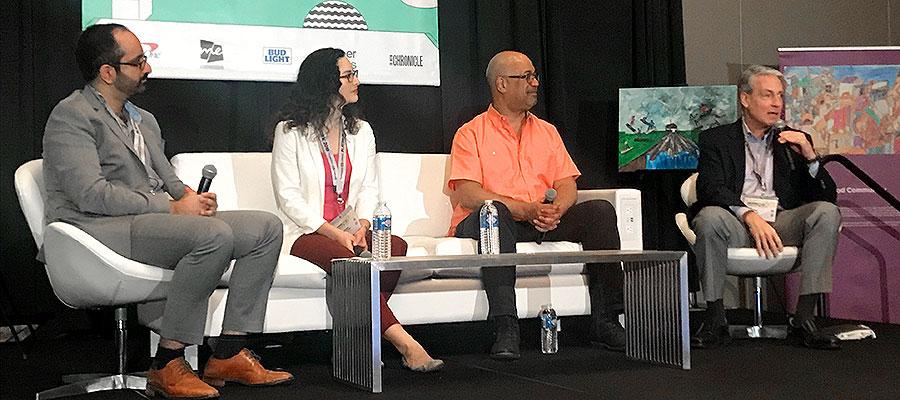Insights from SXSW: The role of technology in addressing social determinants and driving the next-generation of care

Pictured, from left to right: Manik Bhat, CEO of Healthify, Inc.; Carmen Llanes Pulido, executive director at Go Austin/Vamos Austin; Dwayne Proctor, senior adviser to the president and director at the Robert Wood Johnson Foundation, and Ron Paulus, M.D., former president and CEO of Mission Health.
As part of the South by Southwest (SXSW) festival’s Interactive Health and MedTech track, the American Hospital Association and hospital leaders have been sharing how hospitals and health systems are transforming to advance health in their communities.
AHA partnered with Energizing Health to create opportunities for health organizations, community advocates, entrepreneurs, and philanthropical organizations to innovate and collaborate on initiatives aimed at addressing health equity by eliminating systemic barriers, reducing inequities and building healthier communities. In addition to AHA, participating organizations include the Aetna Foundation, the Robert Wood Johnson Foundation, the Cambia Health Foundation, the St. David’s Foundation, the American Heart Association and the American Cancer Society, as well as civic, hospital and community leaders from across the country.
Read on for highlights of some of the sessions and watch for full coverage all week in AHA Today, as well as key takeaways from the festival in the March 19 issue of AHA Market Scan. You can follow along with AHA on social media or using #SXSW.
Social Determinants and Tech: The Double-edged Sword – Healthy communities require more than just medical care for people after they get sick. They need resources that support people to live their healthiest lives. Technology can be an enabler but it can also be a divider in vulnerable communities.
In this session, Ron Paulus, M.D., president and CEO of Mission Health; Manik Bhat, CEO of Healthify, Inc.; Carmen Llanes Pulido, executive director at Go Austin/Vamos Austin; and Dwayne Proctor, senior adviser to the president and director at the Robert Wood Johnson Foundation, explored how technology innovations can help improve safety, nutrition, education, health care access and social supports and how community organizations, entrepreneurs and health systems are working together to ensure safety and health for all.
Paulus shared how Mission Health, headquartered in western North Carolina, has to focus on the social determinants of health to improve the health and well-being of its patients given the numerous social challenges in the rural community. He described how Mission Health’s community investment committee solicited proposals directly from the community and were rigorous about evaluation, measurement and performance to ensure they were truly meeting the community’s needs. Paulus noted that what he saw was “transformative.”
Paulus said he is “bullish” on technology as one way to make headway on the social determinants, but organizations must engage their communities in discussions on how to address the social determinants to ensure they are making the right investments in the right services.
While the panel outlined how technology can be helpful if it is tracking and helping to overcome true barriers to healthy living, it has to be carefully implemented and monitored to be sure it does not inadvertently perpetuate biases or create additional barriers to access.
Financing and the sustainability of the technology can also be barriers in communities that are already vulnerable, the panel stressed.
Health Care’s Digital Disruptors: Hope Vs. Hype – Many are betting big that new technologies will disrupt health care and transform the way care is delivered moving forward. But will these technologies be a boon or a bust?
In this session, Edward Ellison, M.D., co-CEO of The Permanente Federation (a group of eight Permanente Medical groups across the country); Ira Nash, M.D., senior vice president and executive director of Northwell Health Physician Partners; and Lisa Suennen, group lead for digital and technology and head of the venture fund at Manatt, Phelps & Phillips, examined three technologies – predictive analytics, machine learning and precision medicine – and made predictions for how they will impact care.
Overall the panel agreed that predictive analytics is farthest along with more applications. Machine learning is beginning to make an impact and precision medicine – especially related to genomics – has a long way to go.
Predictive analytics is already driving changes in medicine. Ellison noted how advanced monitoring alert systems can predict a patient will deteriorate up to 24 hours before. This allows providers to call in a rapid response team to rescue the patient early and then have the opportunity to involve the patient and his or her family in the next-step decisions. Analytics can also identify risk of readmission within 30 days. Nash shared how predictive analytics can identify not just patients at risk but which interventions may be most effective for those patients. However, the panel cautioned about both over or under reliance on predictive analytics and noted that data integrity is key to usefulness. For example, bias can be perpetuated in algorithms.
Machine learning is another area that offers a wealth of possibilities for health care with its capability to recognize patterns and extrapolate opportunities, but will only be “as good as the data we feed the machine,” noted Nash.
Nash described how technology is moving from medical providers to consumers, and machine learning may change how diagnostic testing is done in the future. The panel cautioned that machine learning will not take place of physicians but will be adjunctive and supportive to them.
Suennen said that precision medicine is still in its infancy with limited applications in some oncology and other practices, but most applications are still emerging. She predicted that 20-30 years from now, we will have much more knowledge about how to choose interventions based on genomic factors.
Overall, the panel was enthusiastic about the potential for all of these technologies – especially the added potential for wider applications as the technologies inter-relate and include a wider range of data inputs, including social determinants.

